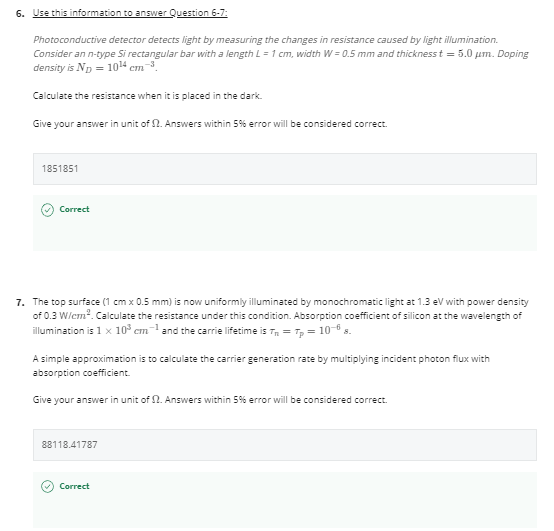6. Use this information to answer Question 6-7: Photoconductive detector detects light by measuring the changes in resistance caused by light illumination. Consider an n-type Si rectangular bar with a length L = 1 cm, width W = 0.5 mm and thickness t = 5.0 um. Doping density is Np = 1014 cm. Calculate the resistance when it is placed in the dark. Give your answer in unit of N. Answers within 5% error will be considered correct. 1851851 Correct 7. The top surface (1 cm x 0.5 mm) is now uniformly illuminated by monochromatic light at 1.3 ev with power density of 0.3 W/cm?. Calculate the resistance under this condition. Absorption coefficient of silicon at the wavelength of illumination is 1 x 10° cm-1 and the carrie lifetime is = T, = 10-6 s. A simple approximation is to calculate the carrier generation rate by multiplying incident photon flux with absorption coefficient. Give your answer in unit of 2. Answers within 5% error will be considered correct. 88118.41787 Correct
6. Use this information to answer Question 6-7: Photoconductive detector detects light by measuring the changes in resistance caused by light illumination. Consider an n-type Si rectangular bar with a length L = 1 cm, width W = 0.5 mm and thickness t = 5.0 um. Doping density is Np = 1014 cm. Calculate the resistance when it is placed in the dark. Give your answer in unit of N. Answers within 5% error will be considered correct. 1851851 Correct 7. The top surface (1 cm x 0.5 mm) is now uniformly illuminated by monochromatic light at 1.3 ev with power density of 0.3 W/cm?. Calculate the resistance under this condition. Absorption coefficient of silicon at the wavelength of illumination is 1 x 10° cm-1 and the carrie lifetime is = T, = 10-6 s. A simple approximation is to calculate the carrier generation rate by multiplying incident photon flux with absorption coefficient. Give your answer in unit of 2. Answers within 5% error will be considered correct. 88118.41787 Correct
Delmar's Standard Textbook Of Electricity
7th Edition
ISBN:9781337900348
Author:Stephen L. Herman
Publisher:Stephen L. Herman
Chapter1: Atomic Structure
Section: Chapter Questions
Problem 6RQ: How many valence electrons are generally contained in materials used for insulators?
Related questions
Question

Transcribed Image Text:6. Use this information to answer Question 6-7:
Photoconductive detector detects light by measuring the changes in resistance caused by light illumination.
Consider an n-type Si rectangular bar with a length L = 1 cm, width W = 0.5 mm and thickness t = 5.0 um. Doping
density is Np = 1014 cm.
Calculate the resistance when it is placed in the dark.
Give your answer in unit of N. Answers within 5% error will be considered correct.
1851851
Correct
7. The top surface (1 cm x 0.5 mm) is now uniformly illuminated by monochromatic light at 1.3 ev with power density
of 0.3 W/cm?. Calculate the resistance under this condition. Absorption coefficient of silicon at the wavelength of
illumination is 1 x 10° cm-1 and the carrie lifetime is = T, = 10-6 s.
A simple approximation is to calculate the carrier generation rate by multiplying incident photon fiux with
absorption coefficient.
Give your answer in unit of 2. Answers within 5% error will be considered correct.
88118.41787
Correct
Expert Solution
This question has been solved!
Explore an expertly crafted, step-by-step solution for a thorough understanding of key concepts.
This is a popular solution!
Trending now
This is a popular solution!
Step by step
Solved in 3 steps with 3 images

Knowledge Booster
Learn more about
Need a deep-dive on the concept behind this application? Look no further. Learn more about this topic, electrical-engineering and related others by exploring similar questions and additional content below.Recommended textbooks for you

Delmar's Standard Textbook Of Electricity
Electrical Engineering
ISBN:
9781337900348
Author:
Stephen L. Herman
Publisher:
Cengage Learning

Delmar's Standard Textbook Of Electricity
Electrical Engineering
ISBN:
9781337900348
Author:
Stephen L. Herman
Publisher:
Cengage Learning